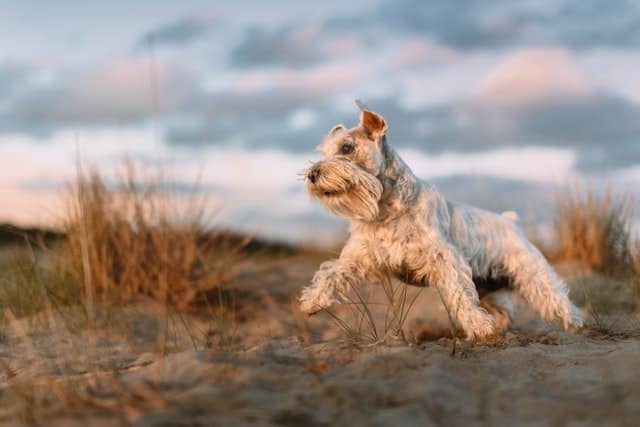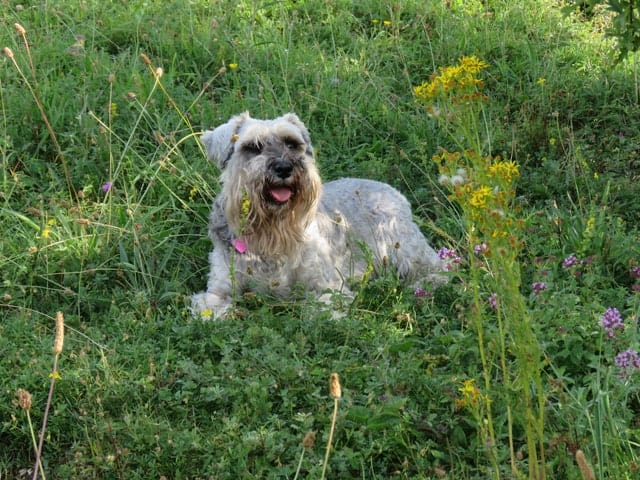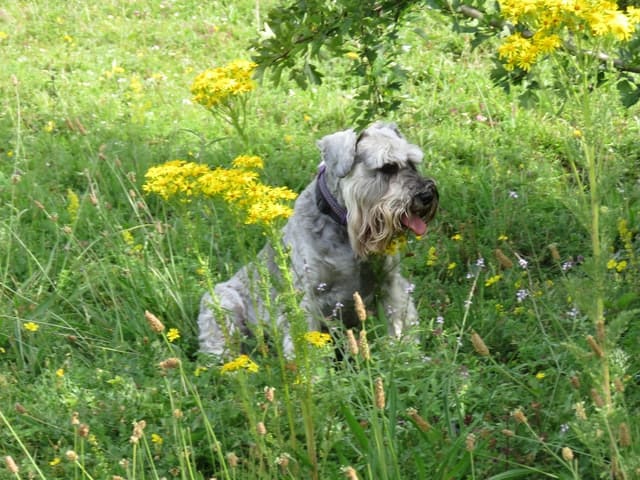The ancestors of the miniature Schnauzer were small stable pinschers that guarded 19th century German, Belgian and Dutch farms (the first records of them come from this period), exterminating rodents.
Contents
- How do Miniature Schnauzers look like?
- How to groom Miniature Schnauzer dogs?
- What character do Miniature Schnauzers have?
- How long do Miniature Schnauzers live?
- Interesting facts about Miniature Schnauzers
- Nutritional tips for caregivers of Miniature Schnauzers
- Health what diseases do Schnauzers get?
- Abilities
- Training and upbringing
- For whom this breed
The German cynologist Johann Bert is most credited with creating the Miniature Schnauzer breed (intentional breeding began around 1880). The first breeding pair was a bitch named Perle von Chemnitz-Plauen and a dog named Prinz von Rhenstein. The four-legged representatives of this breed made their debut at the show in Frankfurt am Main in 1906.
The ancestors of all three varieties of schnauzers (miniature, medium, and giant) were barnyard dogs living in today's Germany and Switzerland. They were initially used to exterminate rodents and guard possessions. In the very beginning, it was not purposeful breeding.
Poor farmers simply needed dogs on the farm. In the 19th century, Schnauzers and Affenpinschers were treated as one breed, and Josef Beta contributed to the separation of the breeds. The name comes from the German "die Schnauze," meaning muzzle or beard, which directly relates to the characteristic appearance of these dogs.
Representatives of this breed came to Poland in the mid-1960s. They quickly became popular, winning the hearts of subsequent owners. According to the International Kennel Club (FCI) division, Schnauzers belong to group II - Pinschers and Schnauzers, Molossers, Swiss Mountain Dogs and Cattle Dogs, section I - Pinscher and Schnauzer type dogs.
How do Miniature Schnauzers look like?

The miniature Schnauzer weighs 4-8 kg, is thick-boned, and has a square body and stocky proportions. A rectangular head, which is half the length of the dog's body, and a characteristic bushy beard are the distinguishing features of this unique breed. Miniature Schnauzers have a double coat (hardcover hair and soft undercoat).
The hair is strong and long on the ears, legs, and belly, while the rest of the body is covered with short hair (according to the standard, it cannot be wavy). Quadrupeds have dark, oval eyes with a lively look, short, high set V-shaped ears, and thin tails. Despite their small size, they are solid and sturdy.
How to groom Miniature Schnauzer dogs?

Miniature Schnauzer does not require special care, although it is essential to be systematic if you want to keep the coat in good condition. You should brush the dog 2-3 times a week, regularly check the state of the ears, take care of dental hygiene and trim the claws (too long reduce the comfort of walking). It is advisable to cut the animal several times a year. How to cut Miniature Schnauzer? It's best to entrust the dog in the hands of a professional and use the help of an experienced groomer.
Schnauzers have a dense and robust coat, protecting the dog from adverse weather conditions. Regular grooming includes combing, which should be done every 2-3 days. A double-toothed metal comb and a brush with wire needles, the so-called poodle brush, are best for this purpose. It must smoothly end the tips of arrows.
The focus should be on the fringe, chin, and paw pads where tangles like to form. When combing out tangles, you should be gentle to not hurt your pet. It is worth using products that make combing more straightforward, especially since combing should not be done dry.
If the claws do not wear off on their own, they should be trimmed from time to time. Regularly check the condition of the eyes and ears - here, the hair growing inside the auricle should be pulled out. Dental chews can help get rid of any tartar. In addition to essential grooming at home, the Schnauzer requires treatments involving trimming and clipping the hair. Trimming consists of removing dead hair and stimulating new hair growth.
We can do this ourselves if we have the appropriate skills, providing the necessary equipment available in good pet stores. If we are not convinced, dog grooming salons will help us, where qualified groomers will care for our pet and guarantee him a natural spa.
Schnauzers should be bathed, if necessary, in shampoos designed for rough-haired breeds. Good news for allergy sufferers will be the fact that Schnauzers practically don't shed their hair, provided it is properly groomed.
What character do Miniature Schnauzers have?

Miniature Schnauzers are bright and very cheerful dogs that are bursting with energy. They have a great need for movement and are always eager to play. They appreciate their guardian's closeness and are well-disposed towards children, although contact with the family's youngest members should be supervised.
They are pretty distrustful of strangers and may do some damage out of frustration and boredom if left for long hours. What is essential, despite vigilance, Miniature Schnauzers are not excessively barking, so they won't be a nuisance for neighbors if we bring them up properly. This breed of four-leggeds will find their way into an apartment and into a house. You just need to provide them with a daily dose of exercise in the fresh air. You can successfully practice with schnauzers flyball, obedience, agility, and frisbee.
Despite its small height, Miniature Schnauzer is not inferior in courage and self-confidence to its more significant relatives. It has a big temperament, strong character, is lively, cheerful, and spontaneous. Miniature Schnauzer strongly attaches to the owner and can demonstrate affection. It needs close contact with its owner and cannot tolerate loneliness, so it should not be isolated. It's a perfect family dog, provided it's in the right hands.
Miniature Schnauzer gets along well with other animals in the house. It is a good friend for older children. However, it may not be suitable for a toddler because, like most small dogs, it doesn't like being treated roughly. However, males can be feisty towards strangers of the same sex, especially if they are more significant than them.
However, this is due to the strong territorial instinct of the miniature rather than aggression. As a dog characterized by innate alertness and remarkable perceptiveness, the Miniature Schnauzer has the makings of a good, if sometimes over-zealous and noisy, watchdog.
His activity means that he is not a couch potato despite his small height and needs daily exercise outdoors. It is undemanding and perfectly adapted to a house with a garden and an apartment in a block of flats.
How long do Miniature Schnauzers live?

Many people wonder how long Miniature Schnauzers live. This is a long-lived breed, so we can enjoy the company of these pets for up to 15 years. Animals are not sickly. They are hardy dogs. However, they tend to get some diseases.
Some of them have von Willebrand's disease, congenital hyperlipidemia, progressive retinal atrophy, epilepsy, and patella dislocation. Some miniature schnauzers also struggle with food allergies.
Interesting facts about Miniature Schnauzers

The first miniature schnauzers appeared in the United States in 1925.
The word "Schnauze," from which the name of the schnauzer breed is derived, means "muzzle" in German.
The Miniature Schnauzer is one of the most intelligent dogs, ranking 12th on the list of smartest breeds.
Nutritional tips for caregivers of Miniature Schnauzers

Miniature schnauzers can be fed both wet and dry ready-made food (optimally in a 1:1 ratio in terms of product weight). It must be a complete food adapted to the animal's nutritional needs, health status, age, and activity level.
Preparing complete and balanced meals for your dog on your own is time-consuming and requires a lot of nutrition knowledge. If you don't have this knowledge, the food may not meet your pet's needs and lead to deficiencies or excesses in his diet, which does not positively affect the health of your Miniature Schnauzer. Instead of spending long hours in the kitchen, it's better to use this time for fun, giving your dog complete ready-made food.
Health what diseases do Schnauzers get?

The Miniature Schnauzer is a long-lived breed that generally enjoys good health. They live on average 12 to 15 years. Providing your dog with the proper diet and activity level will maximize the chance of longevity. This breed is prone to eye diseases, such as retinal atrophy and cataracts.
Less commonly, skin problems can occur, usually caused by poor grooming and an inadequate diet. Some dogs are prone to kidney stones. Disturbing behavior or symptoms should be consulted with a vet as soon as possible, so we can minimize the risk of developing diseases. It is a tough dog and resistant to lower temperatures. During the intense heat, the dog must be provided with a shady place to rest and access to fresh drinking water.
Abilities

These small, rough-haired dogs were used to exterminate rodents in stables and rural homes. They also worked well as farm watchdogs, often accompanying larger dogs at work.
Today, they are primarily family dogs. They are perfect for obedience courses but can also be used for obedience, agility, flyball, or frisbee.
Training and upbringing

Miniature Schnauzer is a brilliant, intelligent, and independent dog. He learns willingly and quickly, and exercises give him pleasure. However, they must be varied and repeated in short sessions because long, monotonous training will quickly bore him. Learning should be based on praise and rewards for good behaviour and their absence in case of disobedience. Physical punishments should be avoided, as they can do a lot of damage to such a sensitive pet.
The Miniature Schnauzer requires a consistent but warm approach. You can not treat the puppy dryly. A representative of this breed left on his own may cause upbringing problems. It is important to properly socialize the puppy - he must meet different people, other dogs, new situations, and visit noisy and crowded places (e.g., train stations, subway stations).
He should be taught basic commands, such as coming when called. Classes in a doggy daycare centre are beneficial. Excessive barking, which often occurs in miniatures, can be largely eliminated by correcting the undesirable behaviour from the beginning.
For whom this breed
The Miniature Schnauzer is a suitable companion for a moderately active, calm, balanced, and consistent owner. A dog of this breed will find itself both in an apartment in the city and in a house with a garden. Basic knowledge of dog breeding is also required.



